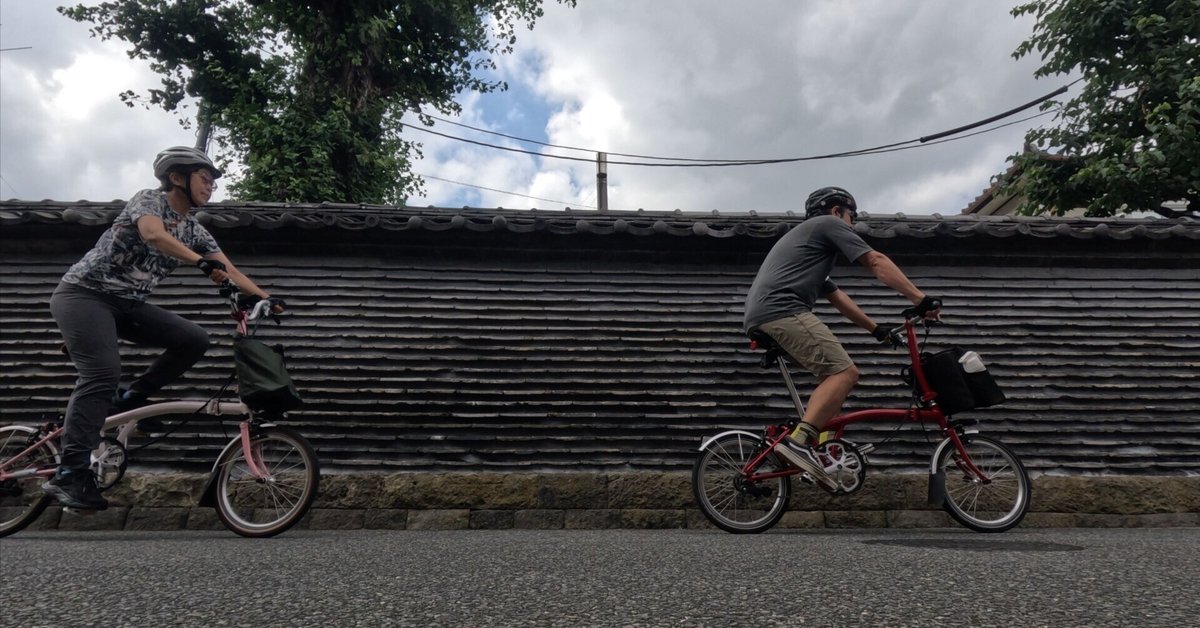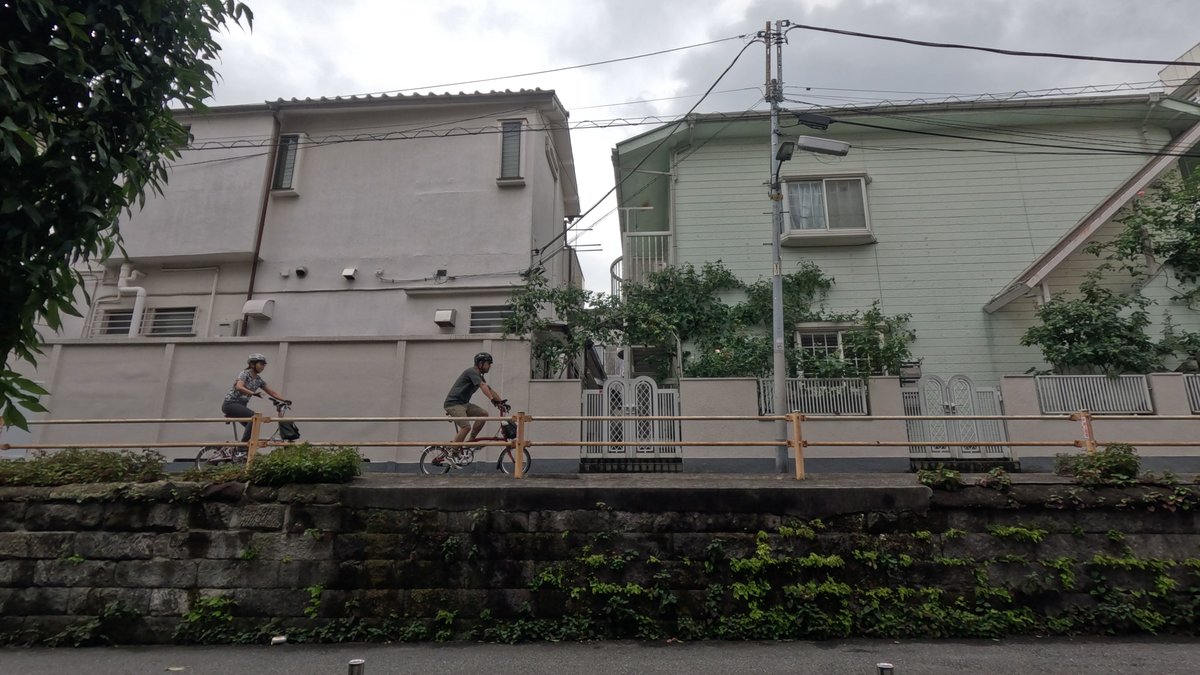
Tokyo “Yanesen“ ride with Brompton
The Yanesen area (Yanaka, Nezu, Sendagi), with its old temples, shopping streets, and charming alleyways, is a popular spot in Tokyo that retains a nostalgic atmosphere.
古い寺院や商店街、風情ある路地が広がり、どこか懐かしい雰囲気を残す谷根千(谷中、根津、千駄木)エリアは、東京の人気スポットだ。
We went out to this area thinking it was a must if we were going to shoot a video of the Brompton Tokyo Ride, but to be honest, we were not very familiar with the area. Nevertheless, we planned a route and off we went.
ブロンプトンの東京ライドの動画を撮影するなら、このエリアは欠かせないと思ってでかけたものの、正直に言えば、私たちはあまりこのエリアに詳しくない。それでも、一応のルート計画を立て、エイッとスタートした。
The plan was to start from Tabata Station, but we deviated from the plan from the beginning and started from in front of Rinshoin Temple, where the grave of Kasuga-no-Tsubone, the nanny of the third Tokugawa Shogun, Iemitsu Tokugawa, is located.
田端駅からスタートする予定だったけれど、最初から計画を外れ、三代将軍徳川家光の乳母、春日局の墓があるという麟祥院の前からスタート。
As we went through the narrow street from the main street as if invited by the bronze statue of Kasuga-no-Tsubone, we noticed that a corner lined with houses was surrounded by a stone wall, which was slightly elevated. Later, I checked an app for a map from the early Meiji period and found that this stone wall was the boundary line of the Rinshoin site.
大通りから、春日局の銅像に招き入れられるように細い道に入り、クネクネと走り抜けると、住宅が建ち並ぶ一角が石垣に囲まれ、少し高くなっていているのに気がついた。あとで明治初期のころの地図をアプリで確認してみたところ、この石垣は麟祥院の敷地の境界線だったようだ。

From there, we rode along the road behind the University of Tokyo to Risaku, an onigiri (rice ball) cafe near Nezu Station for an early lunch. I ordered a set of rice balls and cold sake lees soup for lunch. The onigiri, made with expert hands, were soft and tender, and the sweetness of the rice filled my mouth!
そこから、東大の裏側の道を走り、早めのランチは根津駅近くのおにぎりカフェ「利さく」へ。ランチのおにぎりと冷たい粕汁のセットを注文。慣れた手つきで握られたおにぎりは、ほろりとやわらかく、ごはんの甘みが口いっぱいに広がる。

It was a hot day anyway. We were about seven-eighths full of onigiri (rice ball) lunch on the way to the ride, so next we went to a gelato shop we had set our sights on. As we rode down a narrow street lined with houses and temples, we came upon a small store called “asatte's Gelato,” which had been renovated from an old one-story house.
とにかく暑い日だった。ライド途中のおにぎりランチは腹七分目ぐらいだったので、次は目星をつけていたジェラート屋さんへ。住宅や寺院の建ち並ぶ細い道を走っていくと、asatteのジェラートという古い平家を改装した小さなお店が現れた。
We ordered the standard milk gelato and something a little different: basil gelato. We folded up our Brompton and took those with us to the small backyard rest area. The gelato was refreshing and crisp.
定番のミルクのジェラートと、バジルのジェラートというちょっと変わったものを注文。ブロンプトンを畳んで持って、小さな裏庭の休憩スペースへ。ジェラートはさっぱりとして、さわやかな風味だ。


Next, we went to Tabata Station. Many writers, including Ryunosuke Akutagawa, lived in the area around Tabata Station in the early Taisho period (1912-1926), and there are places where one can feel the history of literature everywhere, such as the remains of Ryunosuke Akutagawa's residence and the Tabata Bunshimura Memorial Museum.
次はいったん田端駅方面へ。田端駅周辺には、大正時代のはじめに芥川龍之介をはじめとする文士たちが多く住み、芥川龍之介の邸宅跡や田端文士村記念館など、随所に文学の歴史を感じられる場所が。
It is also a popular spot for railroad enthusiasts, with the Shinkansen Rolling Stock Center and the Oku Rolling Stock Center, both of which house rolling stock depots for Shinkansen and conventional trains. From the slightly elevated path next to the railroad tracks, we can see a variety of trains running, including bullet trains, conventional trains, and freight trains, which is somewhat exciting even for those who are not railroad enthusiasts.
また、新幹線車両センターや尾久車両センターなど、新幹線や在来線の車両基地のある、鉄道マニアには人気のスポットだ。線路の横の少し高くなった道からは、新幹線、在来線、貨物列車など、さまざまな電車が走る様子を見ることができ、鉄道マニアでなくてもなんだかテンションが上がる。

In addition, there is the historic site of Nakasato Shell Mound, said to be one of the largest shell mounds in Japan, located between the train centers. However, the shell mound itself has been backfilled for preservation and cannot be seen in person.
さらに、車両センターに挟まれた場所には、国内最大級と言われる貝塚、中里貝塚の史跡も。ただ、貝塚そのものは保存のために埋め戻されていて、実際に見ることはできない。

After making a loop around, we returned to the Nippori direction and went through several hills to Yanaka Ginza. Since it was Sunday, the area was crowded with many tourists, so we got off our bicycle and walk, pushing our bikes
ぐるっとひと回りしてから、日暮里方面に戻り、いくつかの坂を経由して谷中銀座へ。日曜日こともあり、たくさんの観光客で賑わっていて、自転車を降りて押し歩きをした。

Passing the ruins of Okakura Tenshin's residence, which is now a small park, we visited Tsuijibei, the Wall of Kannonji Temple. The wall, built of alternating layers of tiles and clay on a stone wall base, was constructed at the end of the Edo period (1603-1868). It is designated as a national tangible cultural property.
The wall at Yodenji Temple across the street is also pretty, so we took videos of both walls.
小さな公園となっている岡倉天心の邸宅跡を通り、観音寺の築地壁(ついじべい)へ。石垣の台座の上に、瓦と粘土を交互に積み重ねてつくられたこの壁は、江戸時代末期に築かれたものなのだとか。国指定の有形文化財にも指定されている。
向かい側にある養伝寺の壁もかわいくて、両方の壁で動画を撮った。

We went through Yanaka Cemetery, where many famous people are laid to rest. There is a sign about the history of Yanaka, explaining that many temples were relocated from Kanda when the area was redeveloped in the center of Edo following the Great Meireki Fire (1657) in the Edo period. The area was almost unaffected by the subsequent Great Kanto Earthquake and other disasters, and the old townscape has been preserved, with many temples remaining today.
たくさんの著名人が眠る谷中霊園を走った。谷中の歴史についての立て看板もあり、このあたりは江戸時代の明暦の大火(1657)をきっかけに江戸の都心部再開発が行われた際、神田から多くの寺院が移転されたとの説明が。その後の関東大震災などでも被災がほとんどなく、古い町並みが保存され、現在も寺院が多く残っているのだそう。

We went to a cafe called Spiq in Yanaka Apartment, where the first floor is a store and the second floor is a rental gallery and share house. It was hot, so we took another break with iced coffee and cake.
1階が店舗、2階がレンタルギャラリーやシェアハウスになっているヤナカアパートメントにある、spiqというカフェへ。暑いので、アイスコーヒーとケーキでまたまたひと休み。

Next, we went to Mikado Bakery, which retains the atmosphere of the Showa period. This store, now closed, was named “Mikado Bread” because of its location on a “triangular lot” between two Y-shaped roads. The large, over 100-year-old cedar tree, which was initially a potted plant, is called a “Himalayan cedar” and has become a symbol of the city. However, one of the large trunks was broken by a typhoon in 2019 and was now heavily pruned.
お次は昭和の雰囲気を残す、「みかどパン」へ。現在は閉店中のこの店は、Y字路にはさまれた「三角地」に位置することから「みかどパン」と名づけられたのだとか。最初は鉢植えだったという樹齢100年以上の大きな杉の木は「ヒマラヤ杉」と呼ばれ、街のシンボルとして親しまれている。ただ、2019年の台風で大きな幹の一つが折れ、現在は大きく剪定されていた。

We entered “a snake path” winding through a residential area. It is said to be a culvert where a stream called Aizome River once flowed.
住宅街をくねくねと通り抜けるヘビ道へ。かつては愛染川という小川が流れていた暗渠だそう。

Then, after seeing the “haunted staircase,” so named because the number of steps is different when going up and down, we turned back and ended the day at Nezu Station.
そして、上るときと下るとき、段数を数えると違ってしまうということから名づけられた「お化け階段」を見たあと引き返し、根津駅でこの日は終了。

There really is a lot to see around here, and I found myself stopping here and there. Bromptons are perfect for getting off the bike and stopping.
There are many hills, but they are just barely long enough to climb with a Brompton. The name of each hill is always indicated, and it is fun to go around while checking the name of the hill.
この辺りは本当に見るものが多くて、あちこちでつい足が止まる。ブロンプトンなら気軽に自転車を降りたり、止めたりできて、ちょうどよい感じだ。
坂も多いのだけれど、ブロンプトンでギリギリ登れる斜度と長さ。それぞれの坂の名前が必ず表示されていて、確認しながら巡るのも楽しい。

It is fun to go directly to each place and tour it leisurely, learning many new things.
それぞれの土地に直接出かけ、のんびりと巡れば、あらめて知ることもたくさんあって、楽しいものだ。
Click here to view the YouTube video↓.
YouTubeの動画はこちら↓
この記事が気に入ったらサポートをしてみませんか?
